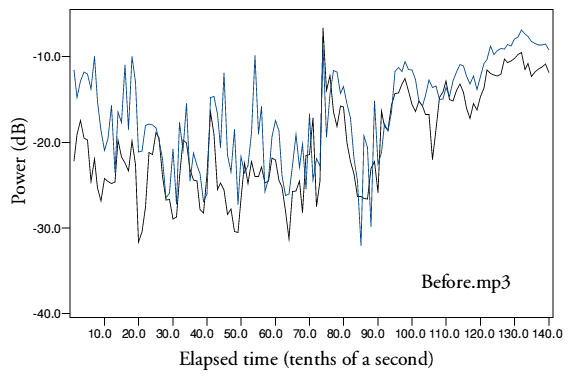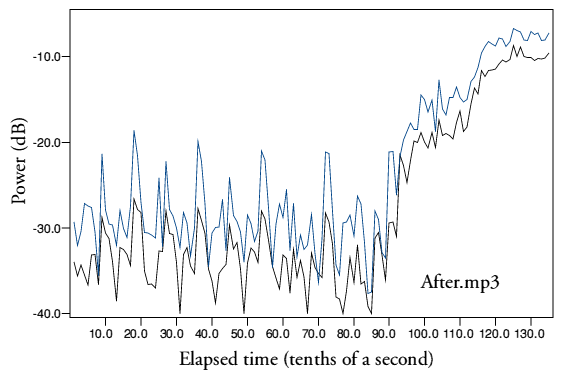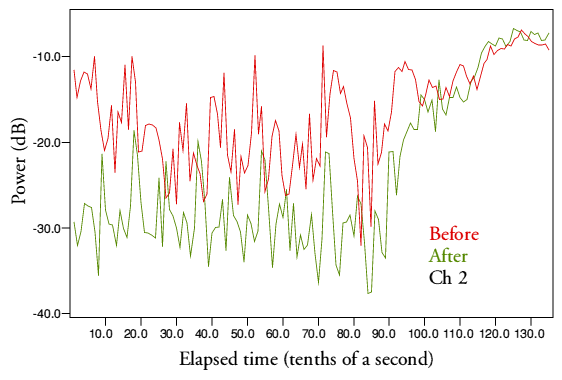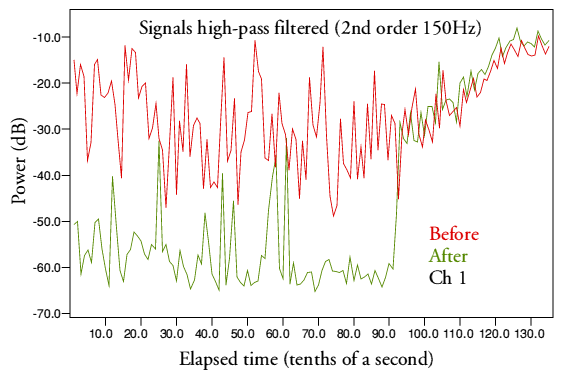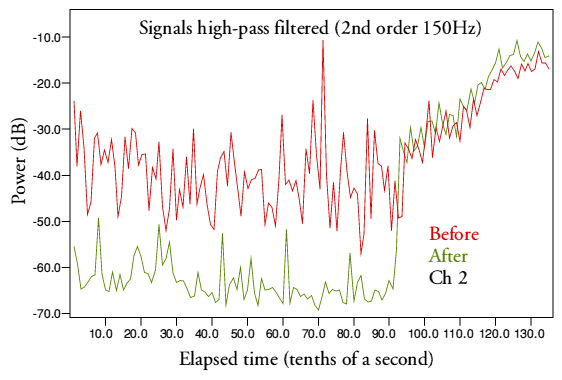Vinyl Solution disc treatment
The graphs on this page were produced by analysing a set of mp3 soundfiles which have been produced to support claims regarding the effectiveness of a specific formulation/method for cleaning/playing LPs. Three soundfiles were provided, nominally of the same LP, ‘before’ treatment, ‘after’ treatment, and then following further treatment/processing. I have no detailed personal knowledge of how the LP was treated, or how the sound samples were created so they are taken here as given. Here I will simply compare the before and after samples, and ignore the ‘pristine’ sample.
Each of the following graphs nominally plots signal+noise power (vertical) versus time (horizontal). The signal is analysed in a series of short time-chunks of 100 milliseconds, and the powers plotted represent the peak power during each period of 100 milliseconds. This gives a pattern broadly similar to that which might be observed using a fast decaying PPM. This method was chosen for computational simplicity, but may have the advantage of emphasising brief clicks which may be more noticeable/objectionable than steady background noise.
The graph above shows the power-time plot for the “before.mp3” example and represents the LP signal before any attempts to clean the LP. The two lines plotted represent the left and right channels. The actual music does not begin until the latter part of the sound sample, so the plots indicate that the SNR is poor.
The above plot shows the results of applying the same analysis as before, but to the “after.mp3” sound sample. The (nominally) noise level before the music starts can be seen to have fallen. To get a clearer view of this we can place the before and after plots on the same graph as shown in the following pair of graphs.
The above compares one channel of the stereo pair (nominally channel 1) with the red line for before, and the green line for after. The comparison implies a general drop in the noise level of the order of 10dB, with some peaks being reduced by larger amounts. It should also be noted that the patterns during the latter part of the samples where the signal is present have also changed, although it is not clear if this is due to noise reduction or to some other alteration of the signal or difference between the samples. For example, the samples may not be well time-aligned.
The above graph also shows before versus after, but this time for the other channel of the stereo pair. The change here seems consistent with the above.
All of the above results are for nominally unfiltered data. One feature of the results presented by the person recommending/selling the cleaning product in question was that the original signal had a quite noticeable amount of noise power below 50Hz. It is not clear why this was present, however it is well known that LF noise tends to be less audible than signals in the range between a few hundred and few thousand hertz. (Hence the use of A weighting in noise measurements.) It was therefore felt worthwhile to repeat the above analysis, but including some high-pass filtering. The following results were therefore taken after applying a second-order high-pass filter to the data with a -3dB roll-over at 150Hz. This will reduce the effect of low frequency input upon the results, and hence may be felt to be a more reliable guide to the audible effects.
The above graph shows before and after for one channel. This plot was produced by almost the same method as before. The only difference being the application of a high-pass filter to reduce any components below about 150Hz. Both the before and after versions were filtered in this way. As a result, the above compares the filtered signals for both before and after.
The above graphs is as the previous one, but for the other channel. It is interesting to note that the apparent change in power level before-after is, for both channels somewhat greater than when we compared unfiltered versions of the the before and after samples. Indeed, it should be noted that I had to increase the power-range plotted from around 40dB to around 70dB for the above plots and this should be taken into account when comparing these results with the previous graphs. Overall, the results may indicate that the reduction in noise is greater at frequencies above 150Hz than below.
The results are interesting in that they do seem to support the claim that the surface noise level is reduced. For the frequencies above 150Hz this reduction seems to be of the order of 20 to 30dB in the examples considered here. That said, I can only base this on taking the example mp3 samples as given, and can't therefore comment on the causes of any changes beyond the above general comment. Also, the above results say nothing about how good or bad the improvement obtained may be compared with alternative treatments of an LP. Hence it is possible that an alternative of some kind is as good, or better. The data presented here does not deal with that question. Finally, it is also possible that my computations were incorrect as they were done quite quickly to form the basis for a discussion!

